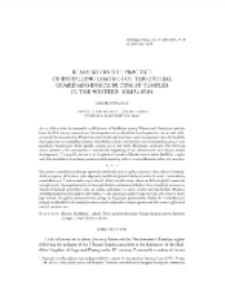
Obiekt
Tytuł: Remarks on the Practice of Installing Lhathos of Territorial Guardians inside Buddhist Temples in the Western Himalayas
Inny tytuł:
Ethnologia Polona 37 2016 (2017)
Wydawca:
Institute of Archaeology and Ethnology Polish Academy of Sciences
Miejsce wydania:
Opis:
Typ obiektu:
Abstrakt:
Kluczowym czynnikiem udanego wprowadzania buddyzmu w społeczeństwach tybetańskich i himalajskich począwszy od X wieku, było włączenie przed-buddyjskich lokalnych mitów do sztuki i architektury nowej doktryny. Przedstawienia terytorialnych sił duchowych zostały włączone do buddyjskich systemów teologicznych i ikonograficznych, podczas gdy lhathos, archaiczne siedziska bóstw, które były uważane za siedziby lokalnych strażników, stały się częścią architektury w całym krajobrazie himalajskim. Poniższy artykuł przedstawia kilka studiów przypadku, w celu opisania początków tego zjawiska oraz omawia dalszy jego rozwój. Szczególne zainteresowanie polega na fizycznym przeniesieniu lhathos do ortodoksyjnych świątyń buddyjskich i ich instalacji w zaszczytnych miejscach w halach zgromadzeń lub nawet w głównych niszach sanktuarium
Bibliografia:
Bellini C. (in print). Some Pieces of the Puzzle: The Restoration of the Alchi gSum brtsegs by bKra shis rNam rgyal and Other Considerations
Denwood P. 2015. The Dating of the Sumtsek Temple at Alchi. In E. Lo Bue and J. Bray (eds.), Art and Architecture in Ladakh. Cross-Cultural Transmissions in the Himalayas and Karakorum, Leiden – Boston, 159–166
Francke A. H. 2014. Antiquities of Indian Tibet. Vol. 1 Personal Narrative. Archaeological Survey of India. Calcutta (reprint 1994 Archaeological Survey of India, New Delhi)
Goepper R. 1990. Clues for the Dating of the Three-storeyed Temple (Sumtsek) in Alchi, Ladakh. In Asiatische Studien: Zeitschrift der Schweizerischen Gesellschaft für Asienkunde 44 (2), 159–175
van Ham P. 2011. Ladakh’s Missing Link? The Murals of Tragkhung Kowache. In Orientations 42 (5), Hong Kong, 50–57
Jahoda C. 2006. Bemerkungen zur Tradition einer weiblichen Schutzgottheit (srung ma) in Tabo (Spiti Tal, Himachal Pradesh, Indien). In A. Gingrich and H. Guntram (eds.), Der Rand und die Mitte: Beiträge zur Sozialanthropologie und Kulturgeschichte Tibets und des Himalaya, Vienna, 11–54
Kalantari C. 2010. Courtly Cavaliers, Mounted Heroes and Pehar. In E. Lo Bue and C. Luczanits (eds.), Tibetan Art and Architecture in Context, Tibetan Studies: Proceedings of the Eleventh Seminar of the International Association for Tibetan Studies held at Koenigswinter 2006, Halle/Saale, 75–120
Kozicz G. 2008–2009. From Mainamati to Nyarma: Remarks on the Development from Cruciform to Oblong-shaped Temple Lay-outs, Journal of Bengal Art 13 &14, Dhaka, 9–21
Kozicz G. 2010. The Architectural Matrix of the Alchi Sumtsek, Indo-Asiatische Zeitschrift 14, Berlin, 31–41
Kozicz G. 2014. The Tsugla Khang of Tabo and the Three-dimensionality of the Vajradhatu Mandala. In P. van Ham (ed.), Tabo – Gods of Light, Munich, 71–75
Lobsang Zotpa. Rin.chen bzang.po’i rnam.thar
Luczanits C. 2003. Art-historical Aspects of Dating. In I. Kreide-Damani (ed.), Dating Tibetan Art, Wiesbaden
de Nebesky-Wojkowitz R. 1956. Oracles and Demons of Tibet. The Cult and Iconography of Tibetan Protective Deities, The Hague (reprint Kathmandu 1993)
Shakspo N. T. 2012. A Cultural History of Ladakh. Centre for Research on Ladakh, Sabu-Leh
Snellgrove D. and Skorupski T. 1980. The Cultural Heritage of Ladakh II: Zangskar and the Cave Temples of Ladakh, Warminster
Vitali R. 1999. Records of Tho.ling: A Literary and Visual Reconstruction of the “Mother” Monastery in Gu.ge, Dharamshala
Czasopismo/Seria/cykl:
Tom:
Strona pocz.:
Strona końc.:
Szczegółowy typ zasobu:
Format:
Identyfikator zasobu:
oai:rcin.org.pl:66271 ; 0137-4079
Źródło:
IAiE PAN, sygn. P 366 ; IAiE PAN, sygn. P 367 ; IAiE PAN, sygn. P 368 ; kliknij tutaj, żeby przejść
Język:
Prawa:
Prawa zastrzeżone - dostęp nieograniczony
Digitalizacja:
Instytut Archeologii i Etnologii Polskiej Akademii Nauk
Lokalizacja oryginału:
Biblioteka Instytutu Archeologii i Etnologii PAN
Dostęp:
Kolekcje, do których przypisany jest obiekt:
- Repozytorium Cyfrowe Instytutów Naukowych > Kolekcje Partnerów > Instytut Archeologii i Etnologii PAN > Publikacje Pracowników i Wydawnictwa IAE PAN
- Repozytorium Cyfrowe Instytutów Naukowych > Kolekcje Partnerów > Instytut Archeologii i Etnologii PAN > Publikacje Pracowników i Wydawnictwa IAE PAN > Czasopisma bieżące
- Repozytorium Cyfrowe Instytutów Naukowych > Piśmiennictwo > Książki/Rozdziały
- Repozytorium Cyfrowe Instytutów Naukowych > Piśmiennictwo > Czasopisma/Artykuły
- Repozytorium Cyfrowe Instytutów Naukowych > Kolekcje Partnerów > Instytut Archeologii i Etnologii PAN > Publikacje Pracowników i Wydawnictwa IAE PAN > Czasopisma bieżące > Ethnologia Polona
Data ostatniej modyfikacji:
2 lut 2022
Data dodania obiektu:
26 wrz 2018
Liczba pobrań / odtworzeń:
129
Wszystkie dostępne wersje tego obiektu:
https://rcin.org.pl/publication/85948
Wyświetl opis w formacie RDF:
Wyświetl opis w formacie RDFa:
Wyświetl opis w formacie OAI-PMH:
Obiekty Podobne
Galwan, Gulam Rassul (? - 1925). Autor Fohr, Paul (1869– )
Chorol, Tsering
Ossendowski, Ferdynand Antoni (1878–1945) Dewall, Wolf von (1882–1959) Frankfurter Societätsdruckerei. Wydawca
Kohte, Julius. Verlag von Julius Springer.
Kohte, Julius. Verlag von Julius Springer.
Wasilewski, Jerzy S.

 INSTYTUT ARCHEOLOGII I ETNOLOGII POLSKIEJ AKADEMII NAUK
INSTYTUT ARCHEOLOGII I ETNOLOGII POLSKIEJ AKADEMII NAUK
 INSTYTUT BADAŃ LITERACKICH POLSKIEJ AKADEMII NAUK
INSTYTUT BADAŃ LITERACKICH POLSKIEJ AKADEMII NAUK
 INSTYTUT BADAWCZY LEŚNICTWA
INSTYTUT BADAWCZY LEŚNICTWA
 INSTYTUT BIOLOGII DOŚWIADCZALNEJ IM. MARCELEGO NENCKIEGO POLSKIEJ AKADEMII NAUK
INSTYTUT BIOLOGII DOŚWIADCZALNEJ IM. MARCELEGO NENCKIEGO POLSKIEJ AKADEMII NAUK
 INSTYTUT BIOLOGII SSAKÓW POLSKIEJ AKADEMII NAUK
INSTYTUT BIOLOGII SSAKÓW POLSKIEJ AKADEMII NAUK
 INSTYTUT CHEMII FIZYCZNEJ PAN
INSTYTUT CHEMII FIZYCZNEJ PAN
 INSTYTUT CHEMII ORGANICZNEJ PAN
INSTYTUT CHEMII ORGANICZNEJ PAN
 INSTYTUT FILOZOFII I SOCJOLOGII PAN
INSTYTUT FILOZOFII I SOCJOLOGII PAN
 INSTYTUT GEOGRAFII I PRZESTRZENNEGO ZAGOSPODAROWANIA PAN
INSTYTUT GEOGRAFII I PRZESTRZENNEGO ZAGOSPODAROWANIA PAN
 INSTYTUT HISTORII im. TADEUSZA MANTEUFFLA POLSKIEJ AKADEMII NAUK
INSTYTUT HISTORII im. TADEUSZA MANTEUFFLA POLSKIEJ AKADEMII NAUK
 INSTYTUT JĘZYKA POLSKIEGO POLSKIEJ AKADEMII NAUK
INSTYTUT JĘZYKA POLSKIEGO POLSKIEJ AKADEMII NAUK
 INSTYTUT MATEMATYCZNY PAN
INSTYTUT MATEMATYCZNY PAN
 INSTYTUT MEDYCYNY DOŚWIADCZALNEJ I KLINICZNEJ IM.MIROSŁAWA MOSSAKOWSKIEGO POLSKIEJ AKADEMII NAUK
INSTYTUT MEDYCYNY DOŚWIADCZALNEJ I KLINICZNEJ IM.MIROSŁAWA MOSSAKOWSKIEGO POLSKIEJ AKADEMII NAUK
 INSTYTUT PODSTAWOWYCH PROBLEMÓW TECHNIKI PAN
INSTYTUT PODSTAWOWYCH PROBLEMÓW TECHNIKI PAN
 INSTYTUT SLAWISTYKI PAN
INSTYTUT SLAWISTYKI PAN
 SIEĆ BADAWCZA ŁUKASIEWICZ - INSTYTUT TECHNOLOGII MATERIAŁÓW ELEKTRONICZNYCH
SIEĆ BADAWCZA ŁUKASIEWICZ - INSTYTUT TECHNOLOGII MATERIAŁÓW ELEKTRONICZNYCH
 MUZEUM I INSTYTUT ZOOLOGII POLSKIEJ AKADEMII NAUK
MUZEUM I INSTYTUT ZOOLOGII POLSKIEJ AKADEMII NAUK
 INSTYTUT BADAŃ SYSTEMOWYCH PAN
INSTYTUT BADAŃ SYSTEMOWYCH PAN
 INSTYTUT BOTANIKI IM. WŁADYSŁAWA SZAFERA POLSKIEJ AKADEMII NAUK
INSTYTUT BOTANIKI IM. WŁADYSŁAWA SZAFERA POLSKIEJ AKADEMII NAUK


































